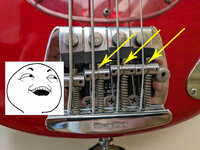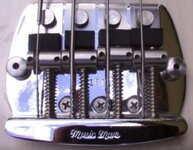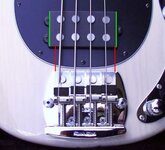zuma
Well-known member
I just gave my early 80s "Charvel era" Stingray a nice little overhaul. My last step was fresh strings. Looking at my stash I decided to use a set of Coated Slinkys, .050, .070, .085, .105. I don't usually use those higher gauges up top. So there I am, with fresh strings installed. I played it for a couple of sessions and was sitting here thinking, "Wow, this is quite a bit stiffer. The action is... bad. I might have to remove these." I decide to give these strings a fair shot and play with the action. I get my tools, I'm about to insert my allen key, then I saw what happened (pic below). Ha ha ha! The strings had a mind of their own and decided a "straight path" was best.
But seriously.... does anyone make aftermarket saddles to "correct" this issue and give the strings a more direct path? My 1991 Stingray is the same. Did the non-mute bridges address this in later Stingrays? I don't own anything past 1991 so I'm just curious.

But seriously.... does anyone make aftermarket saddles to "correct" this issue and give the strings a more direct path? My 1991 Stingray is the same. Did the non-mute bridges address this in later Stingrays? I don't own anything past 1991 so I'm just curious.





